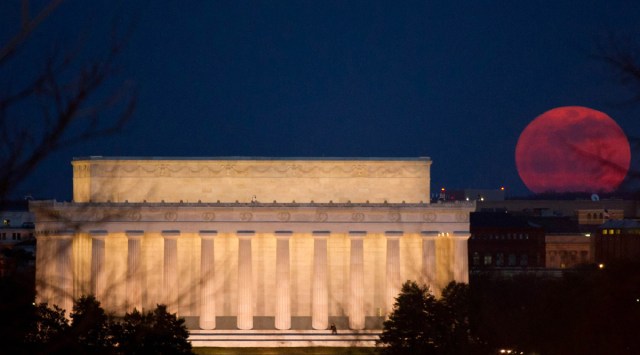2022’s biggest supermoon on July 13; here is what you need to know
The night sky on July 13 will be dominated by the supermoon. But what does that mean and how does it happen?
 A supermoon rising near the Washington Memorial in 2011. (Image credit: NASA/Bill Ingalls)
A supermoon rising near the Washington Memorial in 2011. (Image credit: NASA/Bill Ingalls)On July 13, the night sky was dominated by the largest and brightest moon, called a “Supermoon”. It began at 12.08 AM IST. Here is what a supermoon is and how it happens.
According to Astronomy magazine, the term itself was coined in the year 1979 by the astrologer Richard Nolle and is used to describe what is known as a perigean full moon. A perigean full moon is when a full moon appears when the Moon is at the closest point in its orbit around the Earth. The closest supermoon this year is the one that occurred on the night of July 13 and is referred to as a “Buck Moon”.
This difference in distance between the Earth and the Moon happens because the Moon’s orbit around the Earth is not a perfect circle. The Moon lies at an average distance of 382,900 kilometres from the Earth but its apogee and perigee (closest and farthest points from the Earth) change every month. This happens because the shape of the Moon’s orbit changes over time due to the influence of the Sun and other planets. But one thing that is out of the ordinary is when a full moon happens at the same time as an extreme perigee.
During the July 13 supermoon, the Moon appeared as much as 14 per cent brighter and 30 per cent brighter, according to Space.com. But it is unlikely that you will be able to spot this difference with the naked eye. But the moon might have appeared larger to you when it is near the horizon but that had nothing to do with the distance between the Earth and the Moon. Rather, it had something to do with a phenomenon called “moon illusion”.
The moon illusion is a phenomenon that is acknowledged to be real by the scientific community but there is still much debate about why exactly it happens. Explanations range from our brain automatically comparing it with buildings and other objects in the foreground to our minds simply being wired to process objects in the horizon as being larger than those in the sky.







